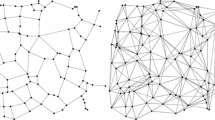Abstract
A geometric spanner on a point set is a sparse graph that approximates the Euclidean distances between all pairs of points in the point set. Here, we intend to construct a geometric spanner for a massive point set, using a distributed algorithm on parallel machines. In particular, we use the MapReduce model of computation to construct spanners in several rounds with inter-communications in between. An algorithm in this model is called efficient if it uses a sublinear number of machines and runs in a polylogarithmic number of rounds. In this paper, we propose an efficient MapReduce algorithm for constructing a geometric spanner in a constant number of rounds, using linear amount of communication. The stretch factors of our spanner is \(1+\epsilon \), for any \(\epsilon >0\).
Access this chapter
Tax calculation will be finalised at checkout
Purchases are for personal use only
Similar content being viewed by others
References
Agarwal, P.K., Fox, K., Munagala, K., Nath, A.: Parallel algorithms for constructing range and nearest-neighbor searching data structures. In: Proceedings of the 35th ACM SIGMOD-SIGACT-SIGAI Symposium on Principles of Database Systems, pp. 429–440. ACM (2016)
Agarwal, P.K., Har-Peled, S., Varadarajan, K.R.: Geometric approximation via coresets. Comb. Comput. Geom. 52, 1–30 (2005)
Andoni, A., Nikolov, A., Onak, K., Yaroslavtsev, G.: Parallel algorithms for geometric graph problems. In: Proceedings of the 46th Annual ACM Symposium on Theory of Computing, pp. 574–583 (2014)
Bakhshesh, D., Farshi, M.: Geometric spanners merging and its applications. In: Proceedings of the 28th Canadian Conference on Computational Geometry, pp. 133–139 (2016)
Birn, M., Osipov, V., Sanders, P., Schulz, C., Sitchinava, N.: Efficient parallel and external matching. In: Wolf, F., Mohr, B., an Mey, D. (eds.) Euro-Par 2013. LNCS, vol. 8097, pp. 659–670. Springer, Heidelberg (2013). https://doi.org/10.1007/978-3-642-40047-6_66
Callahan, P.B.: Dealing with higher dimensions: the well-separated pair decomposition and its applications. Ph.D. thesis, Johns Hopkins University (1995)
Dean, J., Ghemawat, S.: MapReduce: simplified data processing on large clusters. Commun. ACM 51, 107–113 (2008)
Eldawy, A., Li, Y., Mokbel, M.F., Janardan, R.: CG\(\_\)Hadoop: computational geometry in MapReduce. In: Proceedings 21st ACM SIGSPATIAL International Conference on Advances in Geographic Information Systems, pp. 294–303 (2013)
Eldawy, A., Mokbel, M.F.: Communication steps for parallel query processing. In: Proceedings of the 32nd ACM SIGMOD-SIGACT-SIGAI Symposium on Principles of Database Systems, pp. 273–284 (2013)
Eldawy, A., Mokbel, M.F.: SpatialHadoop: A MapReduce framework for spatial data. In: Proceedings of the 31st International Conference on Data Engineering, pp. 1352–1363 (2015)
Farley, A.M., Proskurowski, A., Zappala, D., Windisch, K.: Spanners and message distribution in networks. Discrete Appl. Math. 137, 159–171 (2004)
Ghodsi, M., Sack, J.: A coarse grained solution to parallel terrain simplification. In: Proceedings of 10th Canadian Conference on Computational Geometry (1998)
Goodrich, M.T.: Simulating parallel algorithms in the MapReduce framework with applications to parallel computational geometry. arXiv preprint arXiv:1004.4708 (2010)
Goodrich, M.T., Sitchinava, N., Zhang, Q.: Sorting, searching, and simulation in the MapReduce framework. In: Proceedings of the 22nd Annual International Symposium on Algorithms and Computation, pp. 374–383 (2011)
Im, S., Moseley, B., Sun, X.: Efficient massively parallel methods for dynamic programming. In: Proceedings of the 49th Annual ACM SIGACT Symposium on Theory of Computing, pp. 798–811. ACM (2017)
Karloff, H., Suri, S., Vassilvitskii, S.: A model of computation for MapReduce. In: Proceedings of the 21st ACM-SIAM Symposium on Discrete Algorithms, pp. 938–948 (2010)
Narasimhan, G., Smid, M.: Geometric Spanner Networks. Cambridge University Press, Cambridge (2007)
Nath, A., Fox, K., Munagala, K., Agarwal, P.K.: Massively parallel algorithms for computing TIN DEMs and contour trees for large terrains. In: Proceedings of the 24th ACM SIGSPATIAL International Conference on Advances in Geographic Information Systems (2016)
Navarro, G., Paredes, R., Chávez, E.: t-spanners as a data structure for metric space searching. In: Laender, A.H.F., Oliveira, A.L. (eds.) SPIRE 2002. LNCS, vol. 2476, pp. 298–309. Springer, Heidelberg (2002). https://doi.org/10.1007/3-540-45735-6_26
Rao, S.B., Smith, W.D.: Approximating geometrical graphs via “spanners” and “banyans”. In: Proceedings of the 30th Annual ACM Symposium on Theory of Computing, pp. 540–550 (1998)
van Kreveld, M.: Algorithms for triangulated terrains. In: Plášil, F., Jeffery, K.G. (eds.) SOFSEM 1997. LNCS, vol. 1338, pp. 19–36. Springer, Heidelberg (1997). https://doi.org/10.1007/3-540-63774-5_95
Xia, G.: The stretch factor of the Delaunay triangulation is less than 1.998. SIAM J. Comput. 42, 1620–1659 (2013)
Yaroslavtsev, G., Vadapalli, A.: Massively parallel algorithms and hardness for single-linkage clustering under \(\ell_p\)-distances. arXiv preprint arXiv:1710.01431 (2017)
Author information
Authors and Affiliations
Corresponding author
Editor information
Editors and Affiliations
Rights and permissions
Copyright information
© 2018 Springer International Publishing AG, part of Springer Nature
About this paper
Cite this paper
Aghamolaei, S., Baharifard, F., Ghodsi, M. (2018). Geometric Spanners in the MapReduce Model. In: Wang, L., Zhu, D. (eds) Computing and Combinatorics. COCOON 2018. Lecture Notes in Computer Science(), vol 10976. Springer, Cham. https://doi.org/10.1007/978-3-319-94776-1_56
Download citation
DOI: https://doi.org/10.1007/978-3-319-94776-1_56
Published:
Publisher Name: Springer, Cham
Print ISBN: 978-3-319-94775-4
Online ISBN: 978-3-319-94776-1
eBook Packages: Computer ScienceComputer Science (R0)




